BMW M5: The Ultimate Guide — Every Generation Reviewed
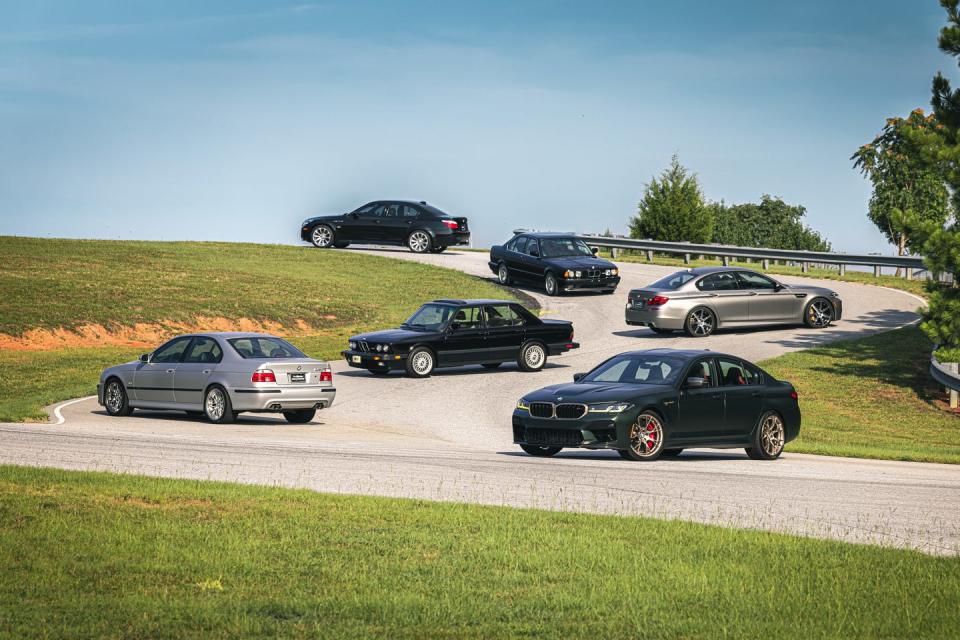
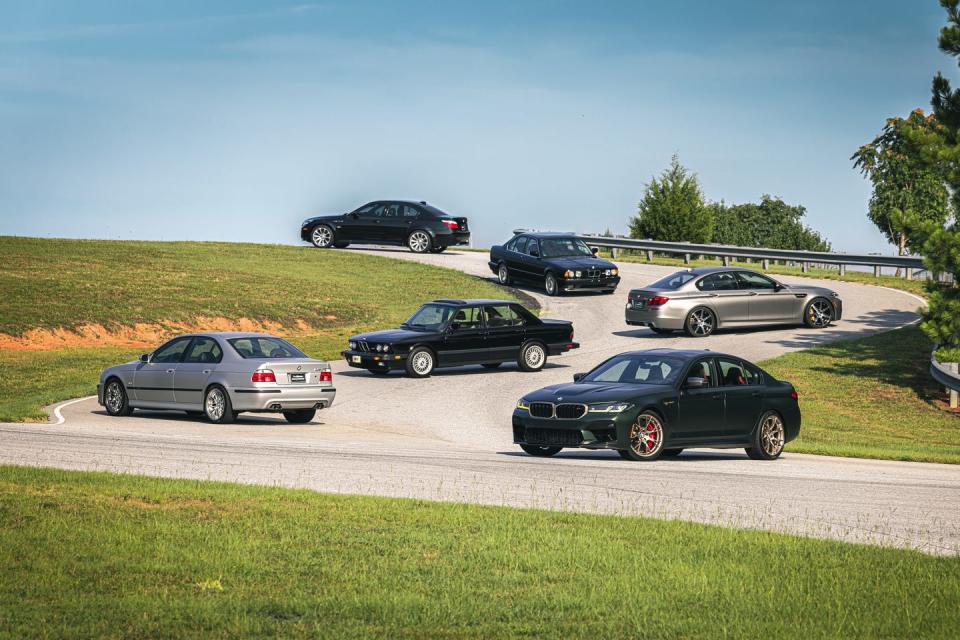
There’s plenty of debate about the origins of the sport sedan in the Fifties. Was the Alfa Romeo Giulietta the first? Or the Jaguar Mark 2? Let that minor controversy continue. We don’t really care because, inarguably, it’s the BMW M5 that has set the standard for four decades.
As the old guy at Road & Track, I’ve driven all six generations of M5. But never all at the same time and in the same place. The opportunity BMW offered to pull examples of each generation from their collection and let us drive them on their Performance Center track in South Carolina was delicious. Digital superstar Aaron Brown came down from New York City, and I shipped myself over from my home in Santa Barbara, California.
There are two elements to every M5 to keep in mind: the “5” part and the “M” part.
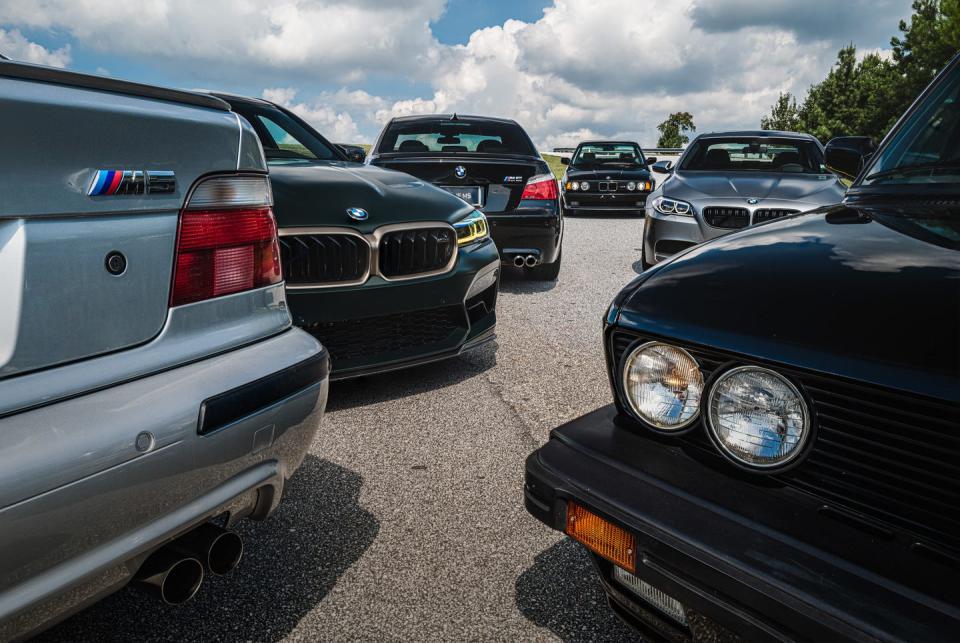
BMW’s 5-Series from its European introduction during 1972 was the quintessential mid-size sport sedan. The original 5, the E12, had a body designed in collaboration by Frenchman Paul Bracq (who had done elegant Mercedes like the W113 “Pagoda” SL roadster before moving to BMW) and Italy’s Marcello Gandini (the maniac behind the Lamborghini Miura and Countach). It was an instant elevation of the sport-sedan species and ever since, this 5—even in its regular non-M guise—has been beloved.
The M came from what was BMW Motorsport. That was the company division that went racing, built racing engines, and was generally gonzo. Today, there’s an M badge for, well, too many BMWs, from 2-Series coupes to massive SUVs. Back then, M meant Motorsport.
In the early Eighties, Motorsport was building nutso contrivances like the turbocharged four that was rumored to make 1200-plus hp in the 1983 Brabham BT52 Formula 1 car for qualifying runs. And the glorious 3.0 CSL based on the broad-shouldered E9 coupe. The first M models sold to civilians were directly related to BMW’s racing needs or used components developed for racing. The division’s first sedan was launched in Europe in 1985, based on the second-generation 5-Series. The E28 M5 used a variation of the 3.5-liter straight-six that powered the M1 supercar built to FIA Group 5 racing regulations.
Keep in mind that five of these six cars were pulled straight from BMW’s North American historic collection. The other one came from a cooperative owner. Four of them weren’t registered for street use. Drive time was restricted to running on the Performance Center track. This is a re-familiarization, not a comprehensive test. No one wants to thrash museum pieces.
As things do, the M5 has evolved over time. Here’s a chance to trace that. It is, however, still a 5 and (mostly) an M.
1988 BMW M5 (E28)
“BMW has developed a fascinating new car,” R&T’s Paul Frère reported in the July 1985 issue. “The M5. It must be fascinating as its 286 hp, 26-valve six is one of the finest engines I know.” For the record, there are 24 valves operating atop the M88 3.5-liter six-cylinder engine.
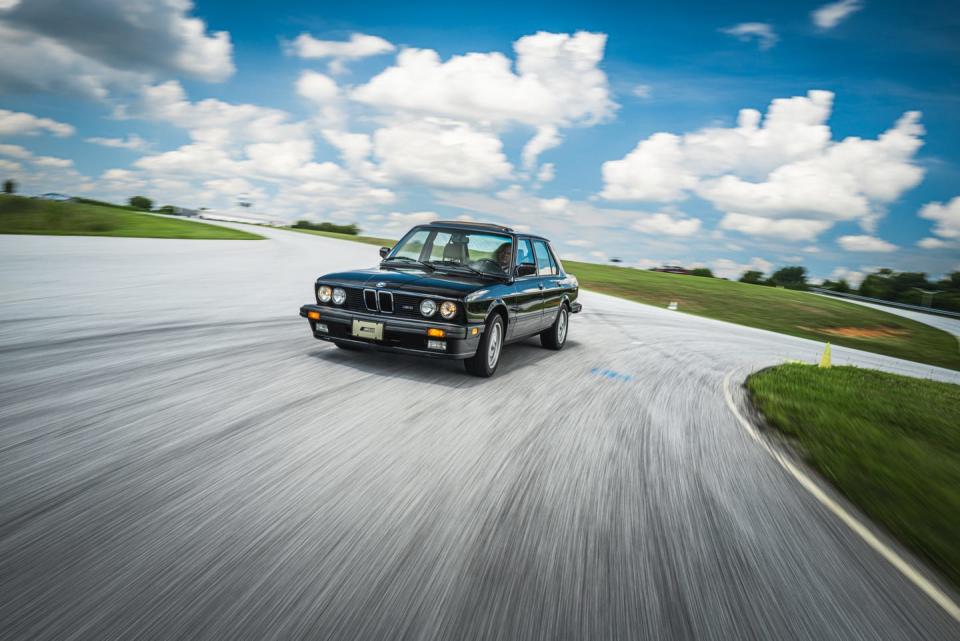
The M5 didn’t make it to America until the 1987 model year, with the M88/3’s output choked down to 256 hp, but it became an instant object of worship anyhow. Approaching it in 2024, it seems ancient. The interior is spartan, the electronics are antediluvian, the driving position is half-bus, the no-airbag steering wheel is so ancient it ought to control a team of horses lashed to a chariot. Though the E28 was the second-generation 5-Series, its greenhouse was largely shared with the 1972 E12, so there’s a superarcane juju about the cabin. So what?
What matters is that the M88/3 possesses six cylinders, six throttle bodies, two cams, and massive charisma. Tractability is an underrated virtue now that everything is either turbocharged or electrified or both—of course there’s always torque on tap. That sensation of available twist is further exaggerated by a short, damn-the-fuel-economy 3.91:1 final-drive ratio and a close-coupled Getrag five-speed gearbox with fourth gear a direct 1:1 ratio and fifth the only overdrive. Lug the E28 M5 in fifth gear, and there’s enough grunt to pull back to speed without downshifting.
Of course no automatic was offered. It wasn’t built for wimps.
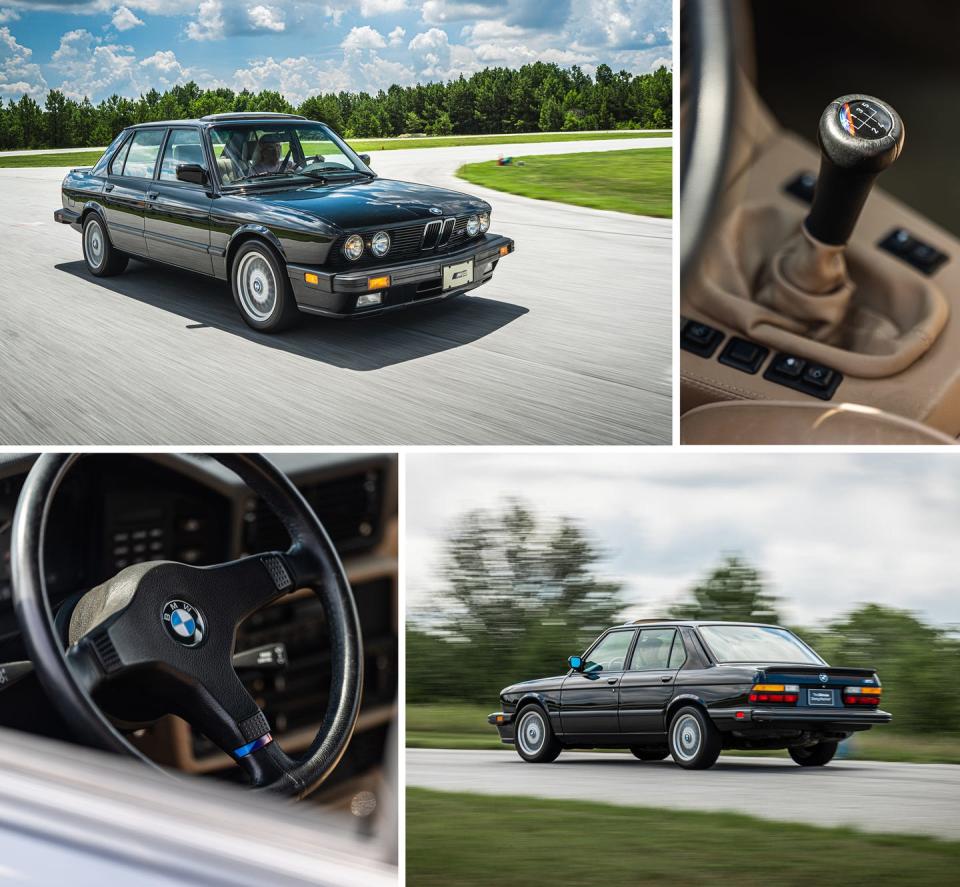
But beyond that, look at that engine. It’s sculpted like classic architecture. It’s the Brandenburg Gate or Cologne Cathedral rendered in aluminum alloy.
Built away from the regular 5-Series production line by the motorsport obsessives, the $48,470 ($131,958 in 2024 bucks) E28 M5 has a quality that’s simultaneously jewel-like and armored. There’s not a lot of adhesion from the 225/50R16 tires, but it communicates its limits vibrantly.
Testing at the time had the 1988 M5 in U.S. spec traipsing to 60 mph in 6.3 seconds and running the quarter-mile in 14.6 seconds at 95 mph. It topped out at 147 mph. Today? Meh. Back then, that was stellar.
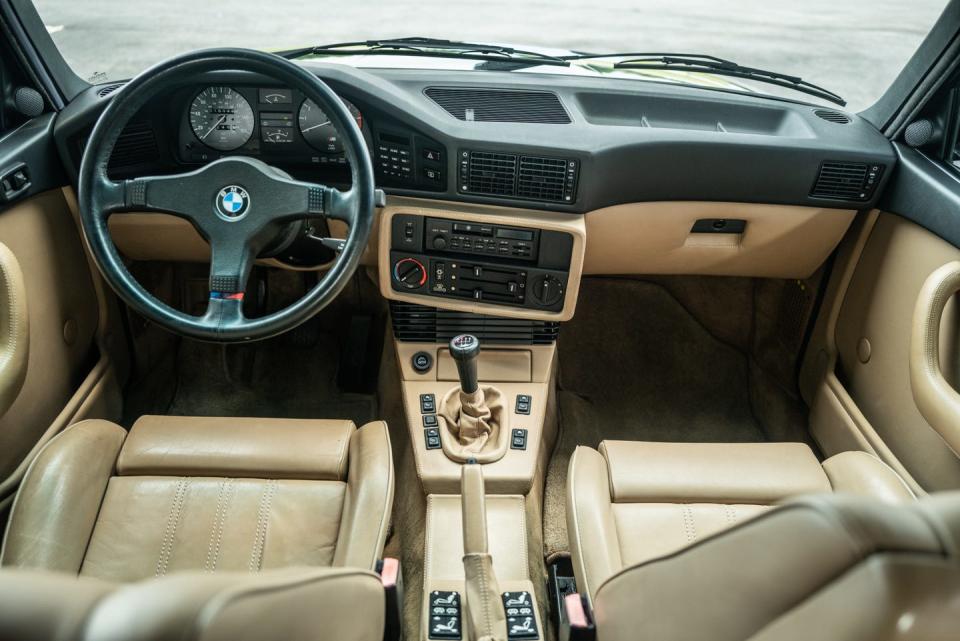
“The M5 is so quick that waiting to pass someone safely creates no frustration: you feel you can afford good traffic manners because the machine quickly compensates for any delays,” wrote Car and Driver’s Larry Griffin. “Its behavior is so calmly composed, so safe and stable at the elevated speeds it readily attains, that in a strange way it calls for added caution: you have to be constantly mindful that trouble can leap up around you too fast for human reaction times to handle.”
That’s all readily apparent 36 years later. The E28 M5 was a one-year only, black-only model in the United States. Between 1985 and 1988 only 2251 were built for all markets. It is, by far, the rarest of all M5s.
1991 BMW M5 (E34)
Introduced in 1987 as a 1988 model and in the United States a year later as an ’89, the third-generation 5, the E34, may not be “peak BMW,” but it’s close. The big leap beyond the E28 was a much stronger structure, more sophisticated interior, and improved suspension. The E34 was a paradigm shift. It’s not going too far to say that every 5-Series since has been a stylistic riff upon it.
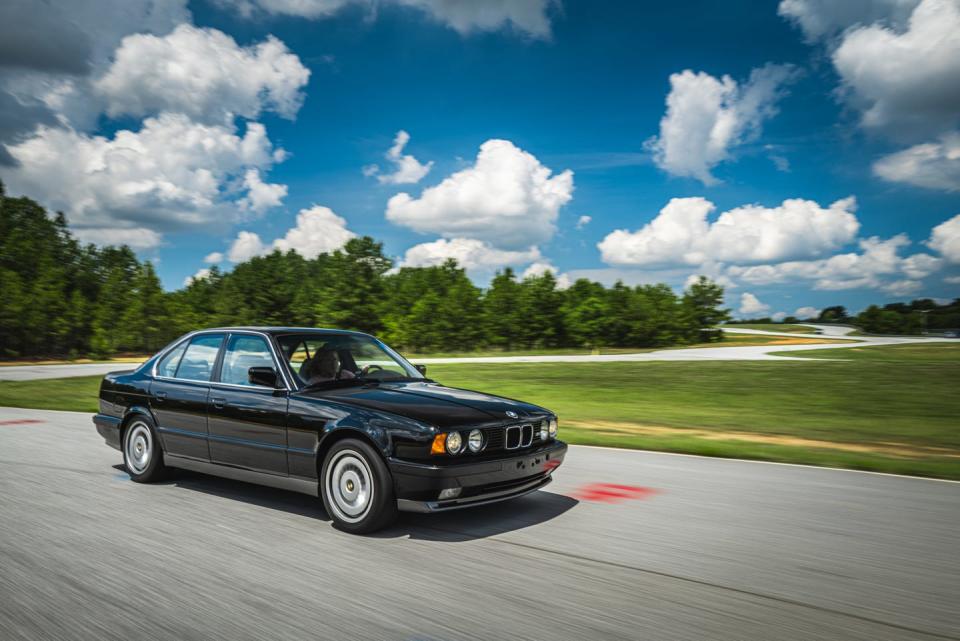
“When the latest 5-Series BMW showed up here a couple years,” our R&T forefathers wrote in the August 1990 issue, “we hoped its M variant wasn’t far off. And here’s that very car, available to a select few North Americans as a 1991 model.”
The E34 M5 is the only M5 without a deck spoiler. There are a few visual differences between it and other E34s—it rides closer to the ground, the front air dam dips a little lower—but it is more buttoned-down than bulked up. A velvet-wrapped hammer inside a velvet glove under multiple coats of velvety paint.
Mechanically, much of the substance from the E28 M5 carried over to the E34. The M88/3 3.5-liter straight-six was still aboard, albeit now rated at 310 hp, and it was backed by the same Getrag five-speed and still turning the same 3.91:1 final-drive ratio.
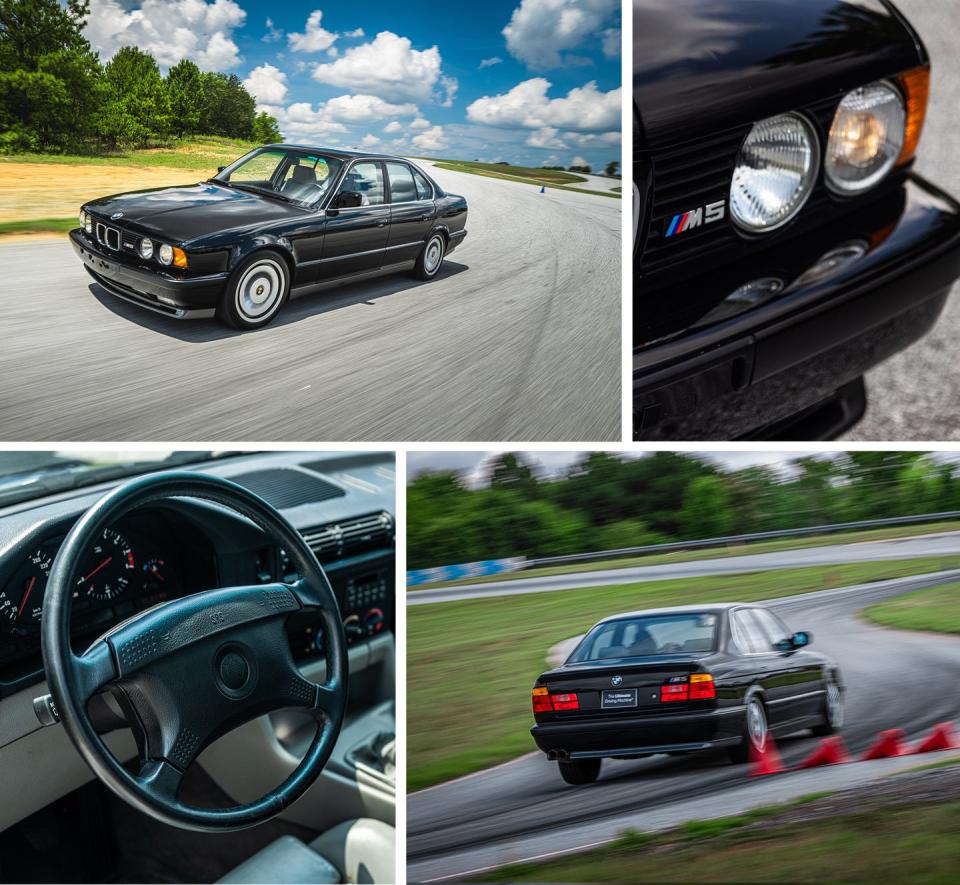
However, that 310-hp rating came at more frantic engine speeds. The E28 version’s peak 251 lb-ft of torque came at 4500 rpm, while the E34’s peak 265 lb-ft was at 4750 rpm. The E28’s horsepower topped at 6500 rpm while the E34’s engine has to spin to 6900 rpm to find its full 310 hp. What that means is though the E34 has more power, it’s not that much more powerful. And it’s marginally less tractable and forgiving. That shows up in the numbers.
In the day, R&T measured the E34 M5 getting to 60 mph in 6.4 seconds and completing the quarter-mile in 15.0 seconds flat. To be fair, Car and Driver had it significantly quicker at 5.6 seconds to 60 mph and a 14.2-second quarter-mile. Testing is a scientific process from either outlet, but variances are inevitable. This happens to be a big variance.
The E34 is always more composed than the E28, and its 235/45R17 tires inevitably mean there’s more rubber knitting it into the pavement. But it’s the vastly more modern ambiance and manners that separate the two more than measured performance. The E28 M5 was a nice start. The E34 M5 is a fully satisfying car even over three decades later.
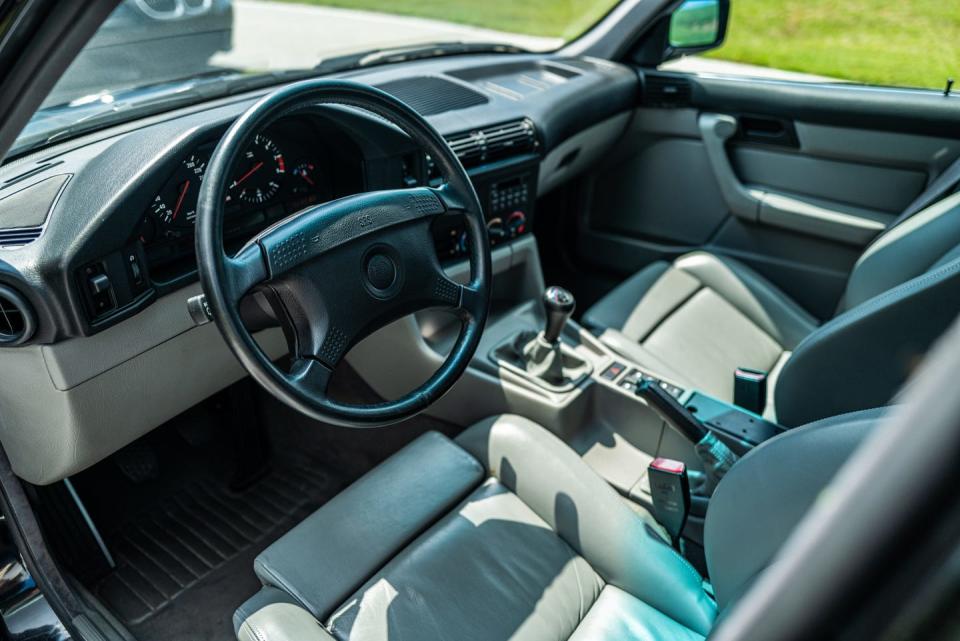
The $59,655 price of the M5 R&T drove in 1990 is the equivalent of $142,417 in 2024.
“Is it worth it?” R&T asked at the end of its first test. “Certainly to a select few. And to the rest, it can still serve as a comforting example of continuity: Considering that the Bavarians all but invented the sport sedan, is it any wonder that they continue to do it so well and with such personality?”
2000 BMW M5 (E39)
“How do you characterize a roomy, four-door, leather-lined luxury capsule that can keep up with a C5 Corvette? All the way to 150 mph,” wrote Car and Driver’s Csaba Csere upon encountering the V-8-powered third-generation M5. “With quarter-mile performance of 13.3 seconds at 108 mph, let’s just call it the fastest production sedan on the planet.”
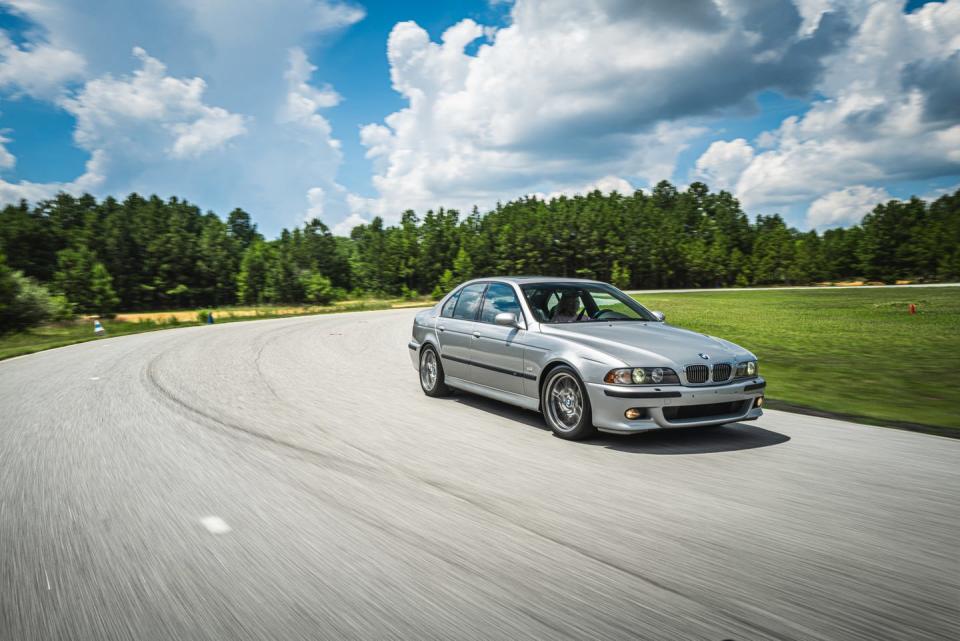
The E39 M5 wasn’t merely an evolution of the species but an inflection point. It had a V-8 engine unrelated to any racing powerplant, it was the first assembled on the same production line as other E39-generation 5-Series sedans (and wagons), and it vastly outsold previous M5s, which, in large part, established the M brand as an ethos and marketing tool that could be applied to practically every vehicle in BMW’s line. After the E39, M didn’t only mean motorsport; it also meant money.
It’s hard to look at the E39 M5 now and consider it an old car. The styling is uncluttered and muscular. The big 18-inch wheels wear meaty 245/40R18 front and 275/35R18 rear rubber, and the four exhaust outlets are purposeful and athletic. From the outside, this is still one of the most exciting-looking four-doors ever built. The anticipation of driving it is literally spine-tingling.
Then the door opens, and the electronics aboard are pure Nokia flip phone. No screens, no paddles, just the orange glow of Bavarian nectarines lighting the instrumentation. Eh, so? It’s the engine that matters.
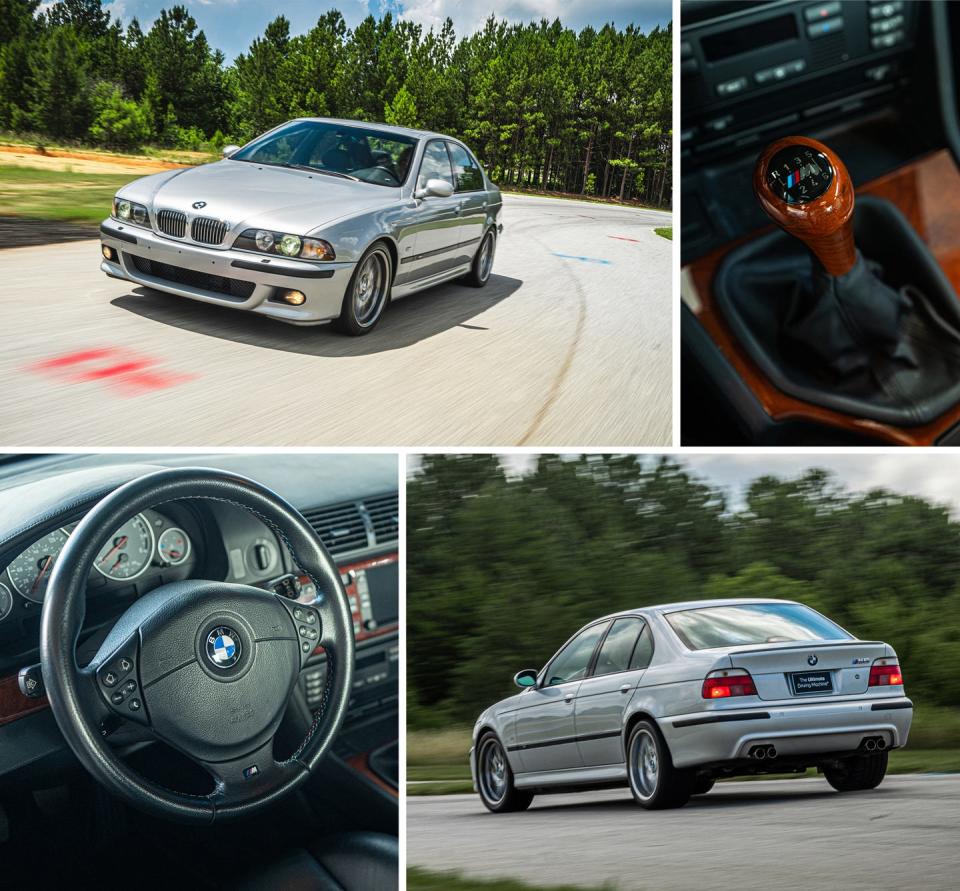
The E39 M5’s engine was based on the existing 4.4-liter V-8 from the 540i Sport but with increased bore and stroke taking capacity to 4941 cc, power rising to 400 hp and 369 lb-ft of torque. The E39 was also the first M5 with variable valve timing and a six-speed manual transmission. Gloriously, BMW still wasn’t selling the M5 with an automatic.
Where the previous M5s produced a soothing trill, the E39 rumbles to life and roars with a NASCAR-like alto. It’s a car any driver could sit in and rev for 20 minutes while parked and get out feeling as if having experienced something thrilling. That’s as true in 2024 as it was in 2000.
Weighing 4000 pounds, the E39 M5 smothers the road unlike the E28 or E34. The shifter takes an intentional shove to find first, but once in there, the E39 skunks out like it’s been hit by a thunderbolt. The later turbo V-8s are more powerful—and the V-10 that comes with the next-generation M5 is a chaos agent—but in daily use, there’s never been a more entertaining drivetrain than the E39 M5’s.
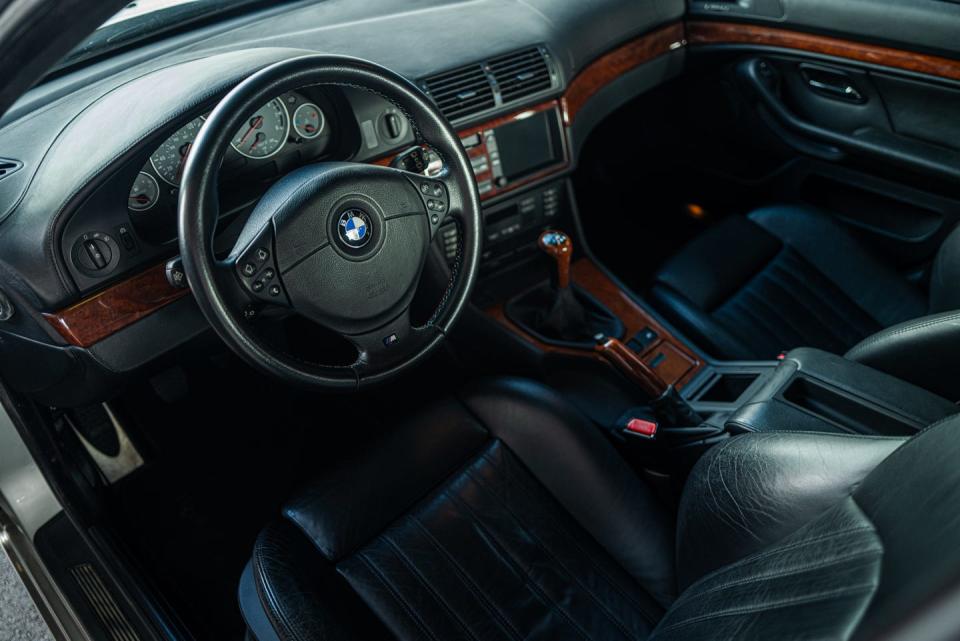
The additional weight and big tires take some liveliness out of the E39’s steering compared to the E34, but it’s a tiny compromise for the expanded performance. R&T measured the E39 M5 thumping to 60 mph in 5.0 seconds and running the quarter-mile in 13.4 seconds at 107.8 mph. Car and Driver had it doing those same tricks in 4.8 seconds and 13.3 seconds at 108 mph.
What those numbers don’t convey is how much fun this thing is. On the Performance Center track, it would push its nose slightly into a corner, then its tail would catch up slyly and slightly and muscle the car out of the turn. This is still the M5 that’s best calibrated to driving on the street.
With three pedals and an engine that’s always on frolic, the E39 M5 has a timelessness about it that previous M5s don’t. Or maybe it’s that the world is still in the E39 M5’s time.
The 2000 M5 started at $69,400 and carried an as-tested price of $73,774 for R&T. In today’s dollars, that’s $127,358 to start and $135,385 as tested. Not cheap. But BMW sold a robust 20,482 globally before production ended in 2003.
2006 BMW M5 (E60)
With its screaming V-10 engine, the M5 took a turn for the exotic with the arrival of the E60 generation for 2005 (it came to America as a 2006 model). Instantly, the then-staff fell in love.
“[The] almighty, all-conquering 5.0-liter 90-degree V-10 is simply magical,” wrote Mike Monticello. “This is a supremely advanced powerplant that uses individual throttle valves for each cylinder tied to an electronically controlled throttle-by-wire system; response is immediate. BMW’s variable double-VANOS camshaft management continuously varies the valve timing to create better high-rpm power and a very consistent torque curve. The result is one of the most free-revving engines ever, along with an insanely potent 500 hp at 7750 rpm and 383 lb-ft of torque at 6100 rpm.”
Yeow.
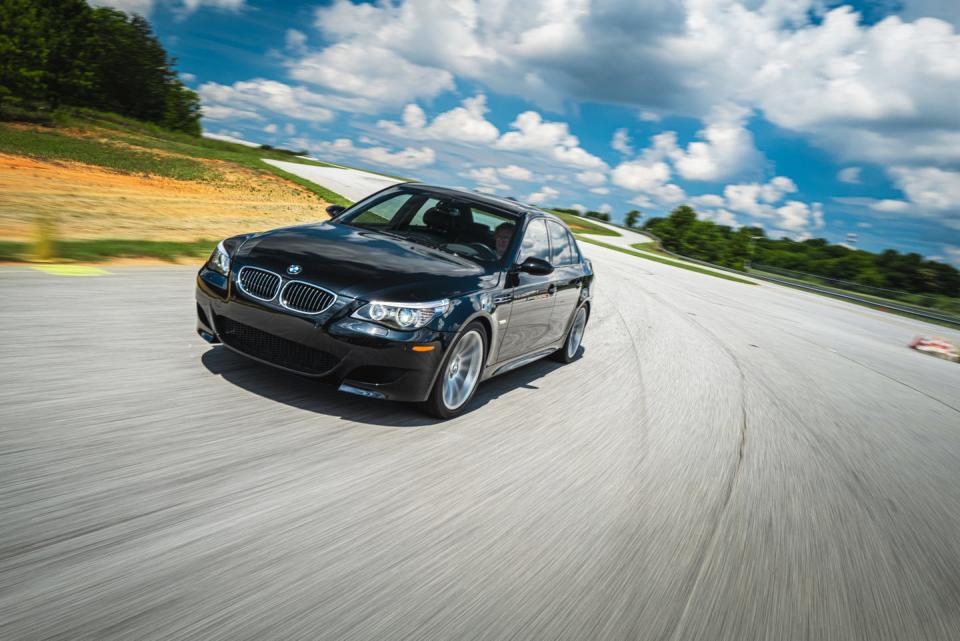
With its bulbous tail—the so-called "bangle butt"—the E60 generation will always be controversial. My take is that it wasn’t pretty then, and it’s not pretty now. But that uneven-firing S85 V-10 is full-on operatic. Other cars start, this one has an overture. It’s mesmerizing.
The dash shapes are odd, and the i-Drive controller looks so 2005 that the E60 has somehow aged less gracefully than the E39. Or the E28 and E34 for that matter. That conceded, the front seats approach ergonomic perfection, the steering wheel is perfectly sized, and the car still has a manual parking brake. The interior is relentlessly black too. But when that engine starts... dear God, it’s like the gates of Valhalla opening.
Rev the engine and an exciting shudder vibrates through the M5’s structure. This example had a six-speed manual transmission, a gearbox exclusively available in North America. A seven-speed “sequential M gearbox” (SMG) automated single-clutch transmission was also offered.
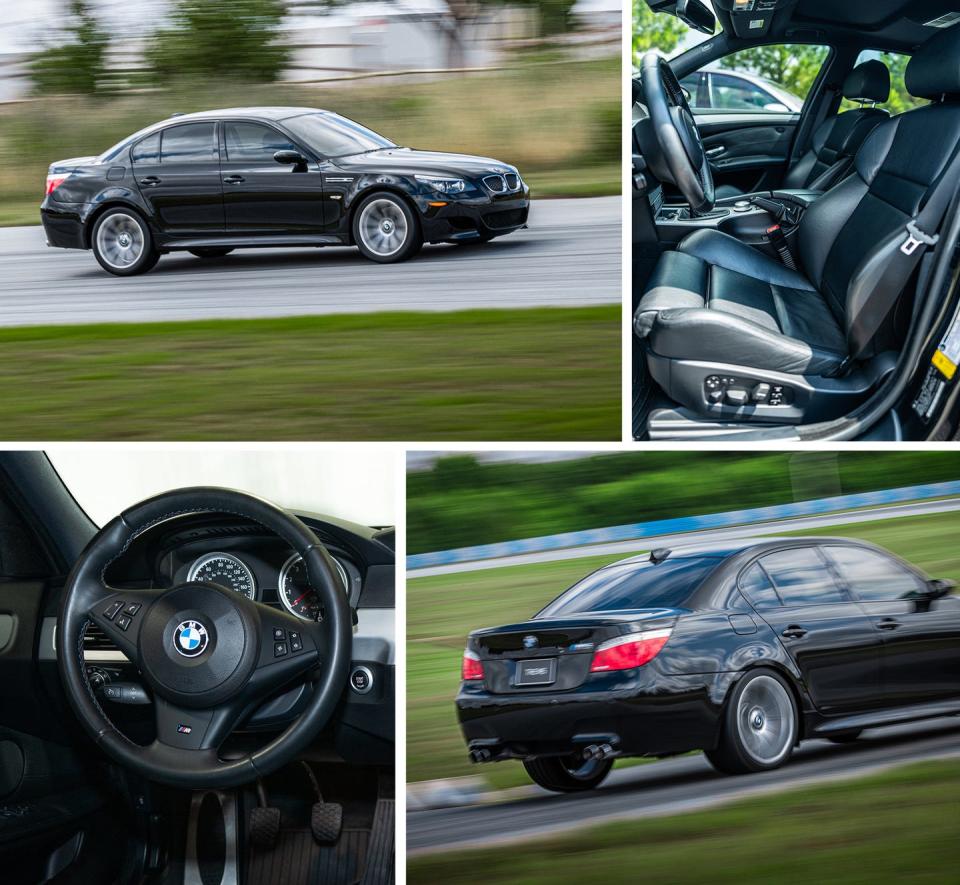
The SMG was a misbegotten distraction, but it was the first automatic available on an M5.
Today, 500 hp seems—if not exactly ordinary—not that astonishing. But that doesn’t capture the thrilling theatricality of this powerplant. It has an 8250-rpm redline which is freaking awesome.
Even on the short chutes of the Performance Center track, the E60 felt ridiculously eager. It’s not built for carving up a small circuit but for swallowing up continents. In the day, I remember driving one on California’s Route 33 loafing into corners for the simple joy of accelerating out hard past the apexes.
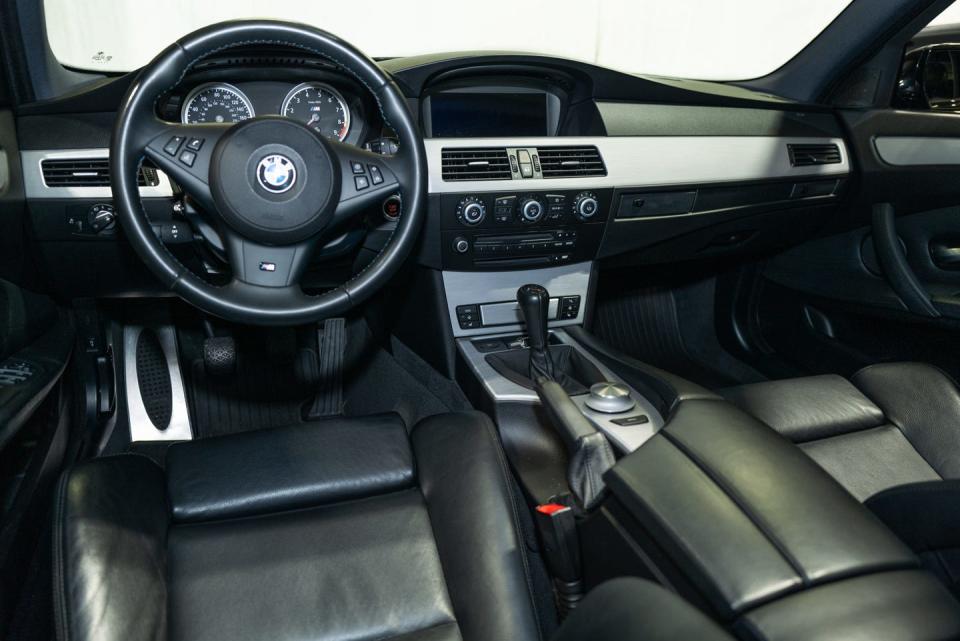
Car and Driver’s test had the E60 M5 with the SMG running to 60 mph in 4.2 seconds and the quarter-mile in 12.5 seconds at a screamtastic 118 mph.
The E60 mixes the most glorious engine ever put in an M5 with the least attractive car. There’s something sterile about the E60 that mutes the engine’s enormous appeal. What the V-10 truly deserved was a home in a mid-engined supercar.
The 2006 E60 M5 started at $84,895 and as-tested prices climbed above $90K. That’s a starting price of about $134,503 today. A total of 20,548 were made for all markets, including 1025 wagons (never sold in the U.S.) before production ended in 2010.
2012 BMW M5 (F10)
After the brilliance of the E60’s V-10, the twin-turbo 4.4-liter V-8 in the F10 generation seems like a sort of betrayal. In specification, it’s the sort of thing one finds in (gack!) Audi or (blech!) Mercedes.
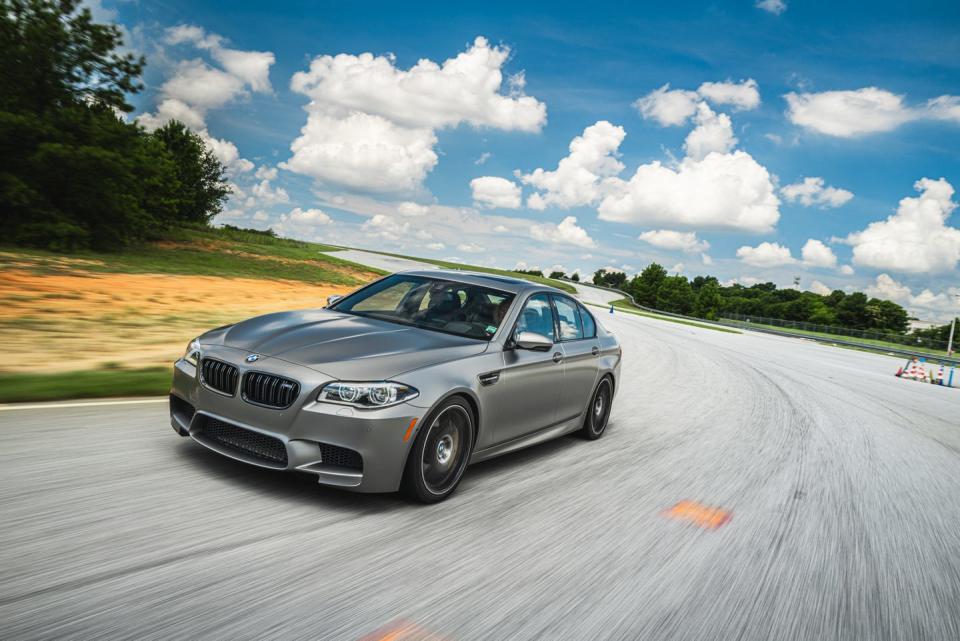
Ah hell, let’s quote Jeremy Clarkson. “It’s wearing a tux,” he wrote for Driving.co.uk, “and you have to look hard to notice the neck like a birthday cake, the chest like a butter churn, the thighs like tugboats. It’s a big bruiser, this car, but there are few clues. Just the blue brake calipers. And some Wallpaper magazine–style LEDs in the door handles. Under the bonnet the old V-10 is gone. In its place is a turbocharged V-8, which is good if you are a polar bear but bad, in theory, if you are a petrolhead.”
Stepping into the F10 is like being shot forward in time a full century instead of a few years. This thing is saturated in tech and even now, a decade on, feels as if it’s brand new. BMW claimed 560 hp for the new turbo wonder and it feels engorged. Yet, nah, it’s not a thriller.
On the Performance Center track the F10 filled the whole road. This was a 30th anniversary edition car and felt overstuffed in celebration. It’s still rear-drive, but it’s a car with minders. It takes a considered effort to scroll through all the menus and turn all the anti-fun tech off. The off switch is, however, the best switch.
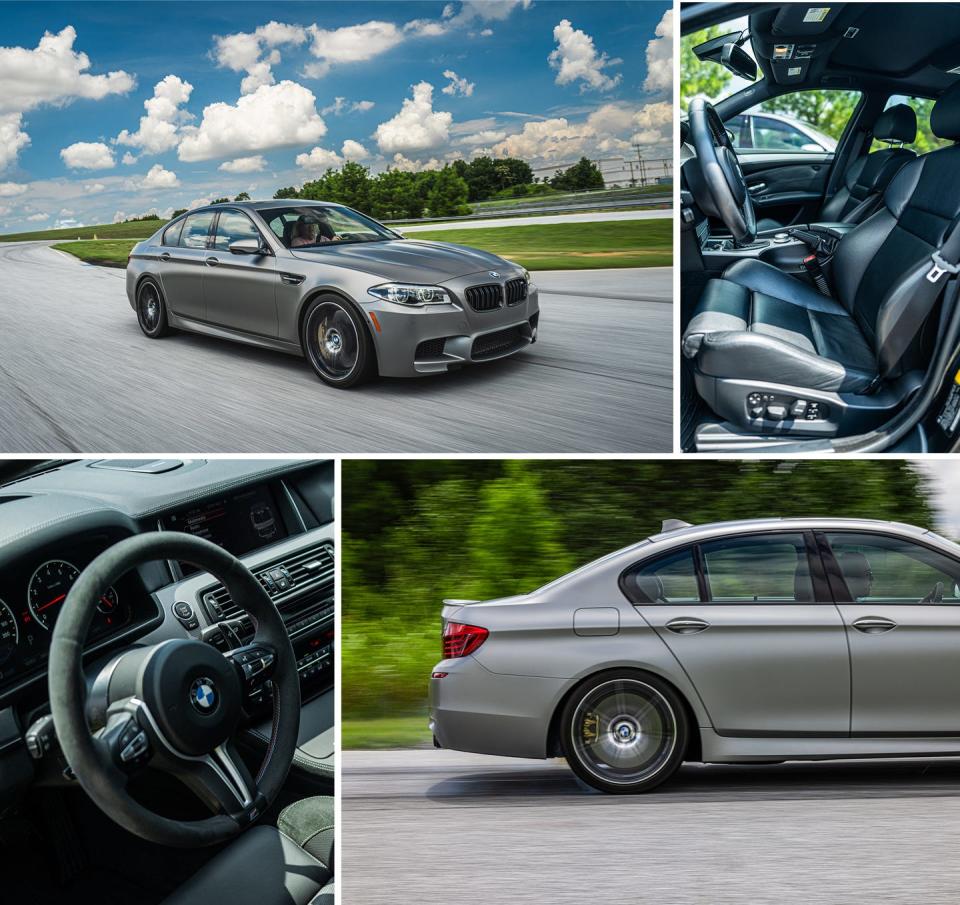
“The manic M5 is a mother to control,” R&T wrote in a comparison test against four V-8 competitors. “Yes, that sounds schizophrenic. But it’s honest. Meeting the M5, you love how the hydraulically assisted steering is old-school-BMW communicative in normal driving, then hate how numb it gets at the limit. You love the steering’s heft but lament that it makes the BMW feel like it weighs as much as two Panameras. The exhaust spits out a crazy howl, but the car’s stereo famously plays pretend engine noise through its speakers. Which admittedly sounds good, but then you kind of resent the fact that you love its pandering.”
“Back and forth. The M5 is blazingly fast and yet miserable to launch. It’s delightfully tail-happy, but we don’t always appreciate the ping-pong the rear end wants to play with the curb. The list goes on.”
There’s no new revelations on the Performance Center course. This is still a luxury car that performs like an exotic. It’s so powerful that the driver can almost feel the engineers back in Munich speaking to themselves, “We’d better give the next M5 all-wheel drive or we’ll kill all our customers.”
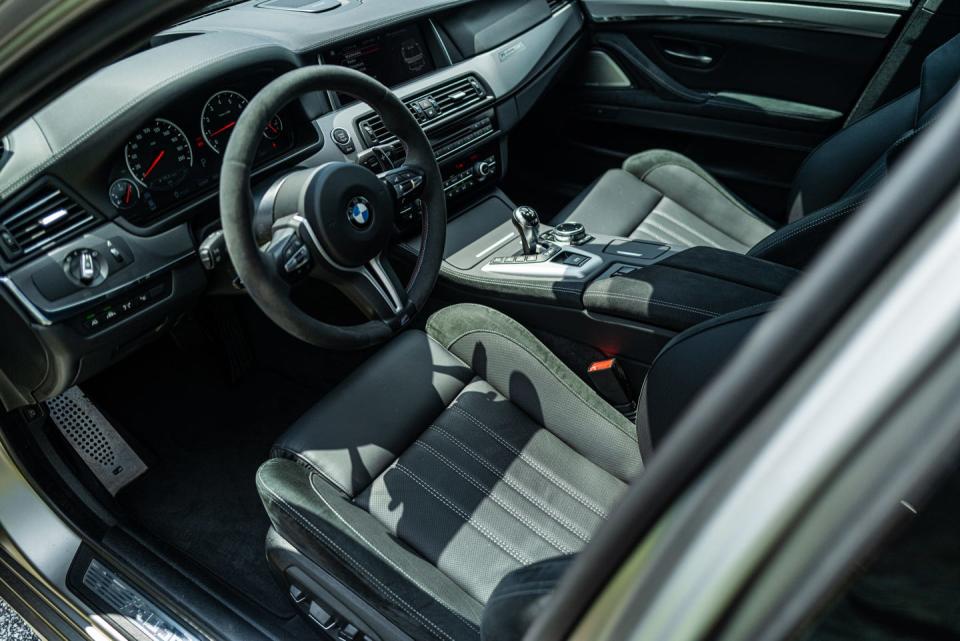
Back then the F10 M5 ripped to 60 mph in just 3.8 seconds and offered a potential top speed of 190 mph. As R&T concluded in the day, “We were always sure which way the BMW would go, because the answer was always sideways. The M5’s suspension is oversprung and underdamped, and without question, the engine makes more power than the chassis can handle. On a bumpy back road, trying to escape the [Mercedes] E63, the M5 is like that little black cat trying to outrun Pepé Le Pew. Driving the M5 fast is serious, countersteering, palm-sweating work.” And it’s still that... which is still a radical kind of cool.
A total of 19,533 were built by the time production ended in 2016.
2018 BMW M5 (F90)
The F90 M5 on hand was a current production M5 Competition model. It’s a brilliant 600 hp machine and the first M car with all-wheel drive. But where exactly could it compete? Is there a luxury performance-car race series that’s so secret no one dare speak of it? Nah, its only competition are the laws of physics. All-wheel drive helps with that.
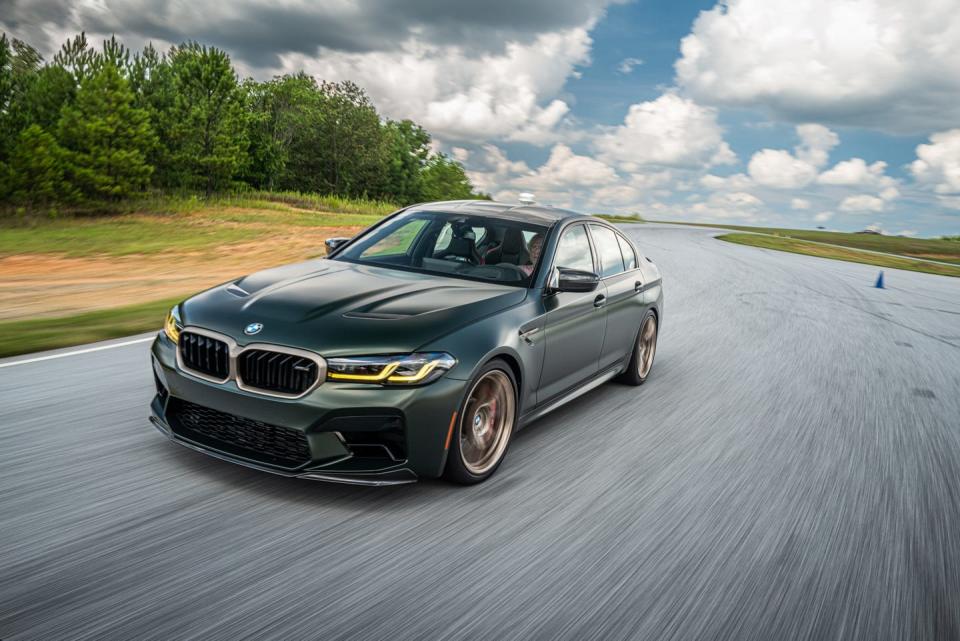
“The [M5’s] all-wheel-drive system is nominally rear-drive—100 percent of torque sent to the rear axle—until the car’s chassis computer sees slip at the front wheels,” wrote Sam Smith for R&T. “On top of this, you can essentially turn the all-wheel-drive system off.”
Through its dizzying array of drive modes, the current M5 can be tailored for any imaginable lunacy. And at the Performance Center, it felt like it was actually consuming the pavement. Only in the context of today, when things like the Tesla Model S Plaid and Lucid Air Sapphire exist, could a car with this staggering performance seem almost conservative.
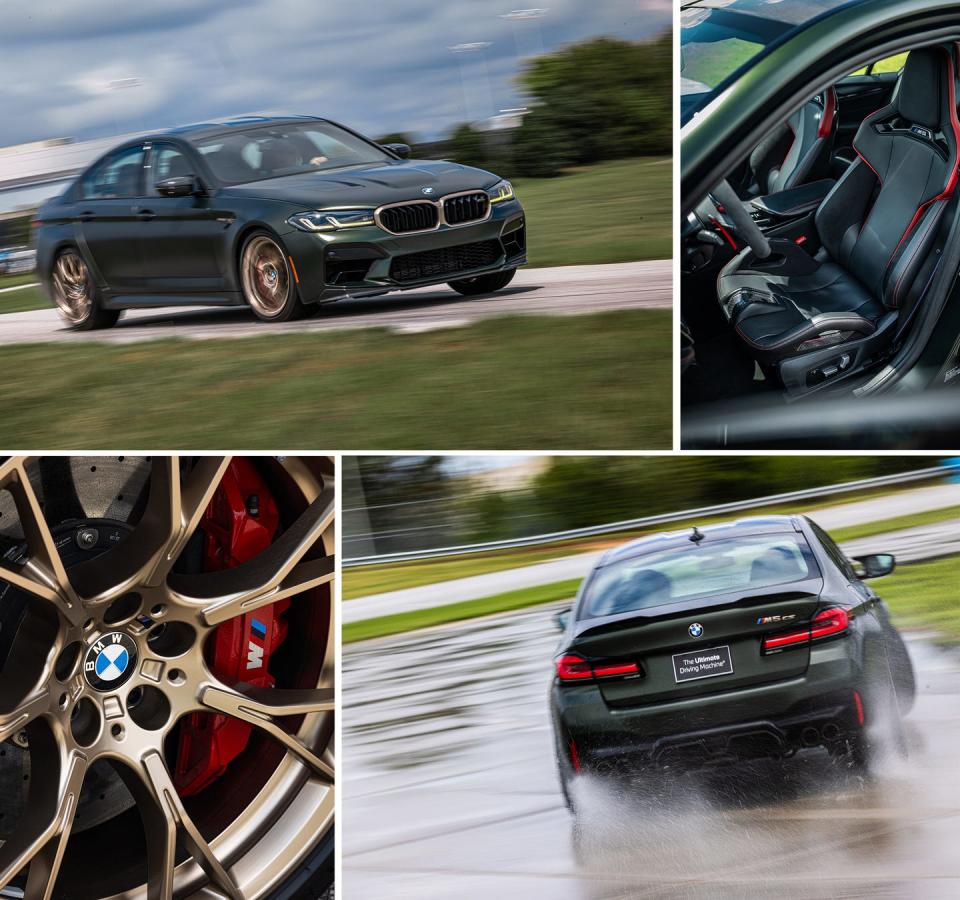
The 2018 used the same basic powerplant as its predecessor, the twin-turbo 4.4-liter V-8 now making 600 hp in regular guise. The punchier Competition turned up to 617 hp.
There are cars that gallop and cars that gobble up roads. The M5 Competition does both; it’s a galloping gobbler. Car and Driver measured one in 2019 ripping to 60 mph in only 2.8 seconds. That’s 0.35 seconds quicker than half the time it took the E28 M5 to reach 60 mph.
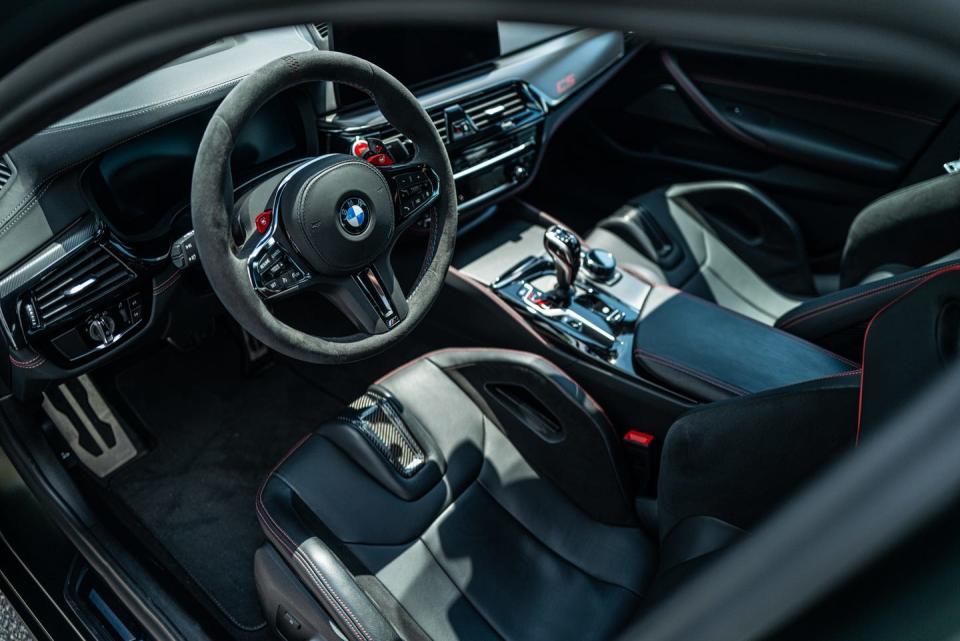
2025 BMW M5 (G90)
The seventh-generation M5 is on its way with a plug-in-hybrid system to supplement its twin-turbo V-8 and a significant weight increase. It will be the most complex M5 so far, but based on this hands-on history lesson, it will need to be truly spectacular to get close to the best of its forebears as an experience.

A car-lover’s community for ultimate access & unrivaled experiences.JOIN NOW Hearst Owned
You Might Also Like

 Yahoo Finance
Yahoo Finance 